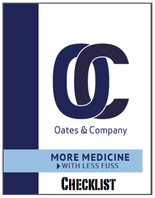Businesses worry about many things: cost efficiency, profitability, inventory, employee management, customer service, etc. Medical practices must worry about all of those and more: confidentiality, record-keeping, insurance, safety, and efficacy.
 Dealing with records as a medical practitioner can be problematic because there are two types of data to record – patient information and business information. Most of the time, two different – and rarely complementary – systems are utilized to maintain the information. For example, many practices use software such as Quickbooks for the business side of their operations while relying on hand-written charts to manage patient care. Now that electronic medical records software is more common, practices are using that instead of hand-written charts, but their business information and patient information are still not combined.
Dealing with records as a medical practitioner can be problematic because there are two types of data to record – patient information and business information. Most of the time, two different – and rarely complementary – systems are utilized to maintain the information. For example, many practices use software such as Quickbooks for the business side of their operations while relying on hand-written charts to manage patient care. Now that electronic medical records software is more common, practices are using that instead of hand-written charts, but their business information and patient information are still not combined.
But they should be. Combining business information and patient information lessens the possibility of errors, increases the accuracy of patient payment reports, allows for automation of invoicing, erases the need for two entries of the same information, and drastically saves time and energy for all involved.
Part of the hold up in implementing this idea is the fact that in order to make it happen, all hand-written information must be “converted” to electronic information. And as many medical practices have years and years of data to enter into electronic medical records systems, this can be viewed as a huge road block.
However, even more so than most companies, medical practices are strongly regulated by the government.
There is the Health Insurance Portability and Accountability Act, which gives patients the right to privacy. This means that before a provider can share patient information with anyone – including insurance companies, legal guardians, pharmacists, specialists, and other practitioners – their patient must sign a disclosure form giving them express permission to do so.
There is Medicare, which guarantees access to health insurance for Americans aged 65 and older and for younger people with disabilities, and Medicaid, which provides health insurance to families and individuals with low income and few resources.
With the upcoming Patient Protection and Affordable Care Act, commonly known as ObamaCare, the United States government’s health care system is attempting its most significant overhaul in 45 years. ObamaCare has two major goals: to increase the affordability and availability of health insurance for consumers and to reduce the costs of health care for providers.
It is doing so with numerous provisions that will slowly be enacted over the course of 10 years; one of those provisions is that all medical providers must have their patient information in an electronic format.
And suddenly, that huge road block that is stopping medical practices from changing data formats is – while still huge – a legal necessity.
So now that moving from paper information to electronic information is a given instead of an option, medical practices need to think even bigger. As in: combining the electronic medical records system with the business system. Integration such as that would have a dramatic effect on the practice – it would no longer be a constant challenge to maintain data and the business becomes easier to run, smoother, and more successful.
Essentially, the medical record-keeping needed to keep patients healthy and the business record-keeping needed to keep the practice healthy come together and the business itself is now healthier.



